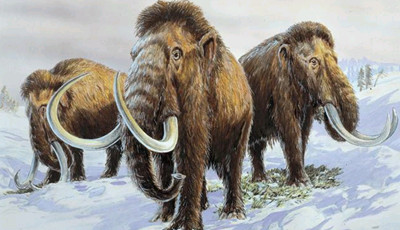(单词翻译:单击)
听力文本
This is Scientific American — 60-Second Science. I'm Christopher Intagliata.
In their heyday, woolly mammoths blanketed the Siberian steppe, Alaska and large parts of North America. But by 10,000 years ago, warming climates had turned many of the grasslands they grazed into forest. And humans, well they weren't so friendly either—one mammoth provides quite a feast. So the mammoths largely disappeared. Except there's this one holdout population. On an island in the Arctic Ocean, called Wrangel Island. Where the last mammoths hid out…for more than 6,000 years.
"So the pyramids have been built, they've started to grow tea in China, and civilization had formed, and here are these mammoths no one knew was there, for the longest period of time." Rebekah Rogers, an evolutionary geneticist at the University of North Carolina. "And then people finally found this island around 3,700 years ago, around the time they went extinct."
Rogers and her colleague Montgomery Slatkin analyzed the genome from the tooth of one of those island mammoths, which lived 4,300 years ago. They compared it to the genome of a mainland mammoth, from much farther back, 45,000 years. And they found that harmful mutations had polluted the island mammoth's genome in that time interval. Mutations that led to the loss of smell receptors, and urine proteins—compounds they probably needed for social signaling and mate choice.

The animals also developed this satiny coat, that shines in the light. A trait that's actually popular for pet breeders today, for rabbits and guinea pigs. And the reason for all these mutations? Rogers says there just weren't enough individuals on the island—1,000 at the most, 300 at their lowest—to allow natural selection to run its course. So it wasn't survival of the fittest. It was survival of...whoever randomly survived. Which meant they accumulated a lot of mutations. None of which made them drop dead—but they weren't all that fit, either. The study is in the journal PLoS Genetics.
Rogers says a similar process could happen for rare animals on Earth today, like cheetahs, pandas, gorillas. "If you have a very small population for a very long time you can get this accumulation of bad mutations in their genomes. And so we'd expect to see the same effect for them. It does take a long time period to get a signal as big as what we saw in the mammoths, so the earlier we can intervene for those species, the better off they'll be."
As for those humans who, long ago, found this last holdout of mammoths on Wrangel Island? "We don't have direct evidence they hunted them, but you kind of wish that they had taken them back and domesticated them." There's already one interested buyer. "Oh yes, if you can find one I would like to have one as a pet. Preferably a little smaller so it fits in my house."
Thanks for listening for Scientific American — 60-Second Science Science. I'm Christopher Intagliata.
参考译文
这里是科学美国人——60秒科学。我是克里斯托弗·因塔利亚塔。
猛犸象在鼎盛时期遍布西伯利亚草原、阿拉斯加和北美大部分地区。但是10000年前,气候变暖逐渐把长毛象赖以生存的草原变成森林。人类对它们也不友好——一只猛犸象能做一顿大餐。所以大多数猛犸象消失了。只有一群还在坚持抗争。北冰洋上有一座小岛名为弗兰格尔岛,最后一群猛犸象在那里躲藏了6000多年。
“金字塔已经建立起来,中国地区已经开始种植茶叶,而且人类文明已经幸存,但是在很长一段时间里都没有人知道这些猛犸象的存在。”北卡罗莱纳大学的进化遗传学家丽贝卡·罗杰斯说道。“人类最终在3700年前发现了这座岛屿,大约在那个时期猛犸象走向灭绝。”
罗杰斯和她的同事蒙哥马利·斯拉特金分析了从其中一只猛犸象牙齿中提取的基因组,这些猛犸象在4300年前生活在岛上。他们将这个基因组同4.5万年前的一只大陆猛犸象的基因组进行了对比。他们发现,在那段时间间隔里,有害的基因突变污染了岛上猛犸象的基因组。基因突变导致猛犸象失去了嗅觉感受器和尿蛋白,而尿蛋白可能是猛犸象发送社交信号和选择配偶时所需要的化合物。
基因突变还让猛犸象一种新的“绸缎外衣”,在光下闪闪发亮的皮毛。现在养兔子和豚鼠的宠物爱好者很喜欢这种光亮的皮毛。发生基因突变的原因是什么?罗杰斯表示,岛上猛犸象的个体数量很少,最多1000只,最少300只,自然选择并未以正常的方式进行。所以,这并不是“适者生存”。而是“随机生存”。也就是说基因突变激增。没有一种突变会让猛犸象死亡,但也不会全都适合猛犸象。这项研究结果发表在《科学公共图书馆·遗传学》期刊上。
罗杰斯表示,类似猛犸象这种过程现在可能发生在猎豹、熊猫和大猩猩等稀有动物身上。“如果在很少时间内,一个物种的数量一直非常长,那它们的基因组可能会积累不良的基因突变。因此,我们会在这种动物身上看到同样的效果。当然,要观察到我们在猛犸象身上看到的那种明显的迹象,需要很长时间,所以我们越早干预这些物种,它们就会越健康。”
那那些很久以前在弗兰格尔岛发现了最后一批猛犸象的人呢?“目前我们没有那些人捕猎猛犸象的直接证据,但是你会希望他们把猛犸象带回去驯养。”已经有一位有意向的买家了。“哦对,如果你能找到一只猛犸象,那我愿意买一只当宠物养。最好是小一些、适合养在我家里的猛犸象。”
谢谢大家收听科学美国人——60秒科学。我是克里斯托弗·因塔利亚塔。
译文为可可英语翻译,未经授权请勿转载!
重点讲解
重点讲解:
1. turn into (使)变成;(使)成为;
例句:The ancient consumer city was now turned into a modern industrial base.
这个古老的消费城市今天已经变成了一个现代化的工业基地。
2. lead to 招致;致使;导致;
例句:Early success may lead to megalomania.
少年得志可能导致妄自尊大。
3. run its course 任其发展;听其自然;
例句:We can't cure the disease; it must run its course.
我们治不了这种疾病,只好听其自然。
4. as for 至于…;
例句:As for my past, I'm not telling you anything.
关于我的过去,我什么都不会告诉你。


